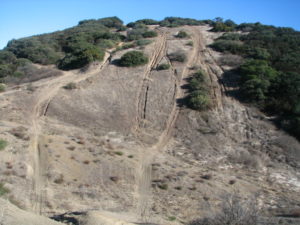Our Off-road Vehicle Monitoring Program
We work to prevent damage caused by illegal and irresponsible off-road vehicle (ORV) enthusiasts. Because the Los Padres doesn’t have enough funding to monitor and maintain existing ORV routes, we oppose the construction of any new ORV routes here. We also support the closure of existing ORV routes that damage wildlife, cultural sites, and wilderness values.
ForestWatch conducts on-the-ground monitoring to identify areas prone to illegal ORV use. Combining resources with agency staff, we hope to put an end to the illegal trespass of ORVs into sensitive areas.
Off-road Vehicle Abuse
The widespread damage caused by off-road vehicles (ORVs) has long been recognized. In 1979, the White House Council on Environmental Quality stated that “off-road vehicles have damaged every kind of ecosystem found in the United States.” A quarter-century later, the proliferation of ORVs on public lands has only made the problem worse.

Motorcyclists trespass in an area along E. Camino Cielo where the vegetation has died due to repeated ORV usage. Photo by Bryant Baker.
The noise, pollution, and speed of ORVs degrade the wilderness experiences of other recreational users, including hikers, horseback riders, hunters, and other forest visitors. These vehicles destroy vegetation and cause severe soil erosion and soil compaction, which in turn leads to increased runoff, flooding, and further erosion. The disruption of soil also promotes the spread of invasive nonnative vegetation. In addition, ORVs affect wildlife through direct collisions, habitat alteration, and overall harassment. Because of these impacts, the Forest Service recently declared ORVs to be one of the top four threats facing our nation’s forests.
Despite the widespread damage caused by ORVs, there is very little regulation of this activity on national forest lands. The regulations that do exist are poorly implemented, and agencies lack sufficient funds to monitor ORV use to prevent trespass into unauthorized areas.
Off-road Vehicles in the Los Padres
The Los Padres offers 980 miles of designated ORV routes and other roads that are open to ORV use. There are also hundreds of miles of undocumented ORV trails, most of which are the result of illegal ORV use on the Mt. Pinos and Santa Lucia Ranger Districts. Areas suffering from the most intensive ORV use include the Mutau/Hungry Valley, Ballinger Canyon, the Highway 33 Corridor, Pozo-LaPanza, and Rockfront. The Los Padres also faces increasing pressure from the popular Hungry Valley State Vehicular Recreation Area, located directly adjacent to the national forest boundary.

Off-road vehicle trespass in the Los Padres National Forest is a significant source of erosion and sediment pollution.
ORV use on the Los Padres is expected to increase by 20% in the next few years. To accommodate this increased demand, the Forest Service is planning up to 494 additional miles of ORV roads within the forest boundaries. Worse, the agency is proposing to establish 733,086 acres exclusively for “backcountry motorized use” in areas that are currently undeveloped and wild. The Forest Service admits that it is unable to currently provide sufficient management and enforcement along existing ORV routes, yet fails to explain how it intends to prevent trespass and resource damage along these new routes.
The proliferation of ORV routes in the Los Padres has damaged sensitive cultural sites, eroded hillsides, and choked waterways with sediment. A recent report by the State Water Resources Control Board identified ORV use as one of the major sources of water quality problems on the Los Padres. And a report by Forest Service whistleblowers disclosed ongoing impacts to 30 cultural sites in San Luis Obispo County, with damage occurring “almost daily” at prehistoric rock art and other sites in the Gold Hill area.






